CIPD Assessment: HR's Evolving Role in the Contemporary Business World
VerifiedAdded on 2020/05/16
|22
|5630
|182
Report
AI Summary
This report, submitted by a student for a CIPD assessment, examines the evolving role of Human Resources (HR) in the contemporary business world. It begins with an executive summary and table of contents, followed by an introduction that highlights the pressures organizations face, such as globalization and technological advancements. The report identifies five key forces shaping the HR agenda: process improvement, talent acquisition, organizational culture, employee engagement, and talent development, along with change management and ethics. It also includes a discussion of the David Ulrich HR model and strategic HR management. The report compares business environment analysis tools, including SWOT and PESTLE, and analyzes factors impacting organizations and their HR functions. The report concludes with an overview of strategy formulation, business performance evaluation, and data sources. This report provides a comprehensive analysis of the HR landscape and its strategic importance.
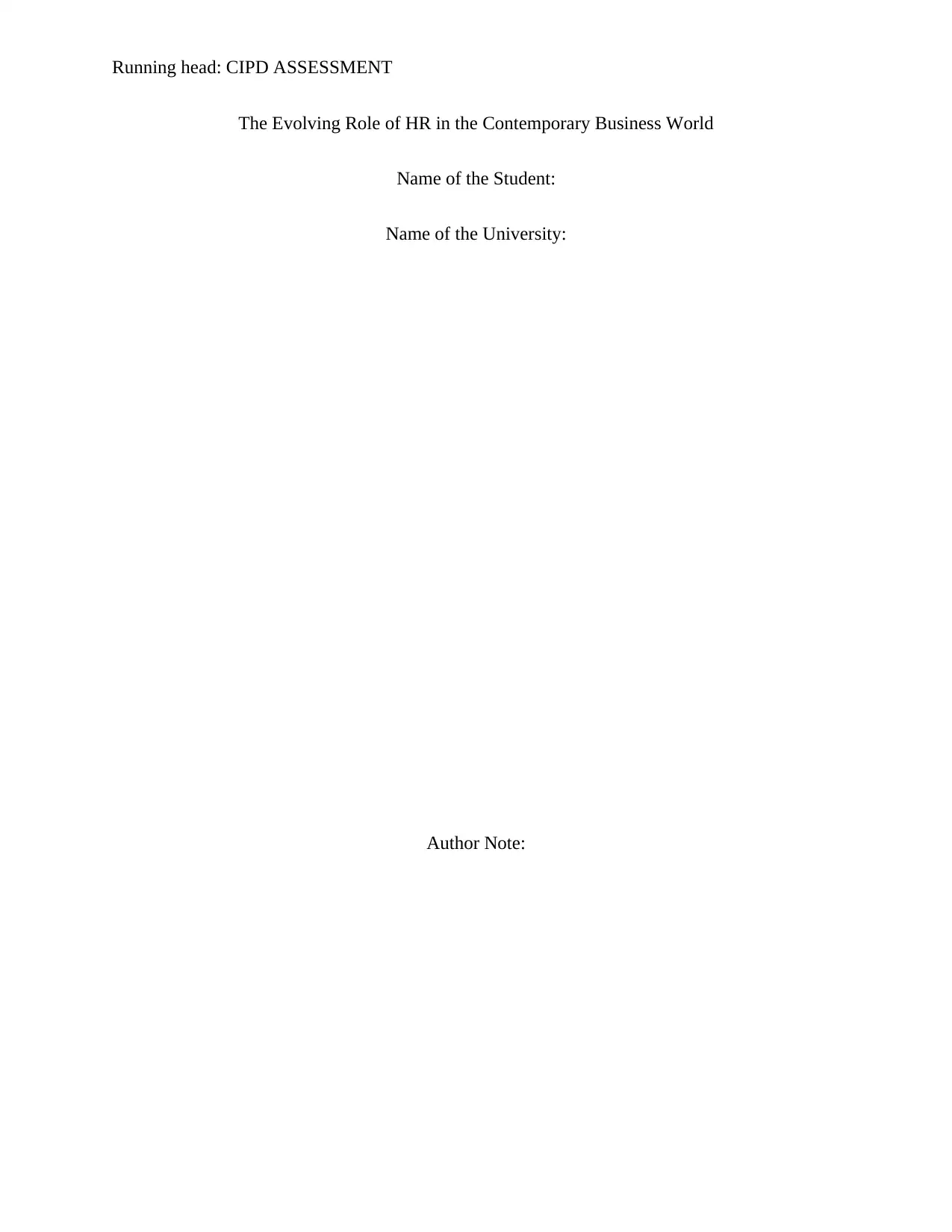
Running head: CIPD ASSESSMENT
The Evolving Role of HR in the Contemporary Business World
Name of the Student:
Name of the University:
Author Note:
The Evolving Role of HR in the Contemporary Business World
Name of the Student:
Name of the University:
Author Note:
Paraphrase This Document
Need a fresh take? Get an instant paraphrase of this document with our AI Paraphraser
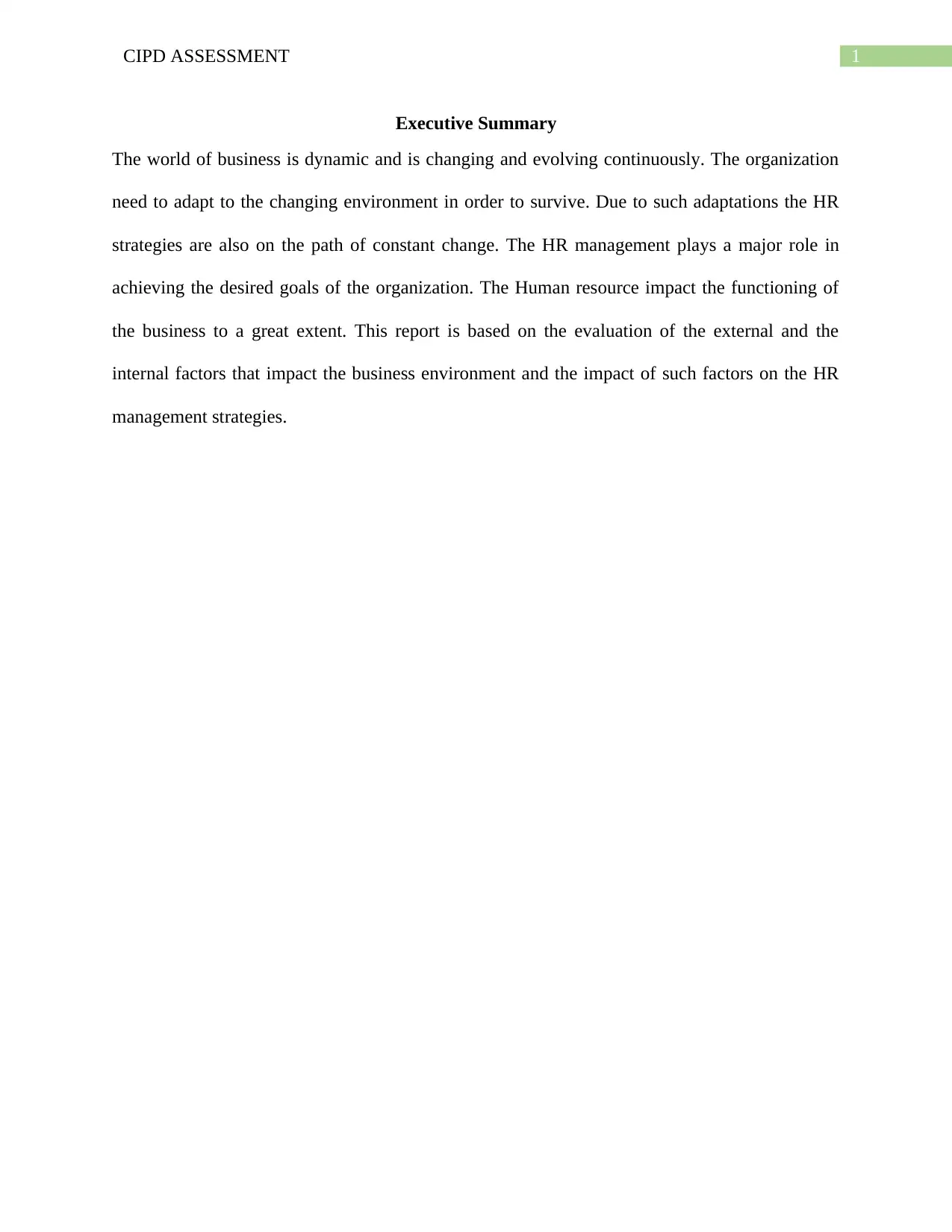
1CIPD ASSESSMENT
Executive Summary
The world of business is dynamic and is changing and evolving continuously. The organization
need to adapt to the changing environment in order to survive. Due to such adaptations the HR
strategies are also on the path of constant change. The HR management plays a major role in
achieving the desired goals of the organization. The Human resource impact the functioning of
the business to a great extent. This report is based on the evaluation of the external and the
internal factors that impact the business environment and the impact of such factors on the HR
management strategies.
Executive Summary
The world of business is dynamic and is changing and evolving continuously. The organization
need to adapt to the changing environment in order to survive. Due to such adaptations the HR
strategies are also on the path of constant change. The HR management plays a major role in
achieving the desired goals of the organization. The Human resource impact the functioning of
the business to a great extent. This report is based on the evaluation of the external and the
internal factors that impact the business environment and the impact of such factors on the HR
management strategies.
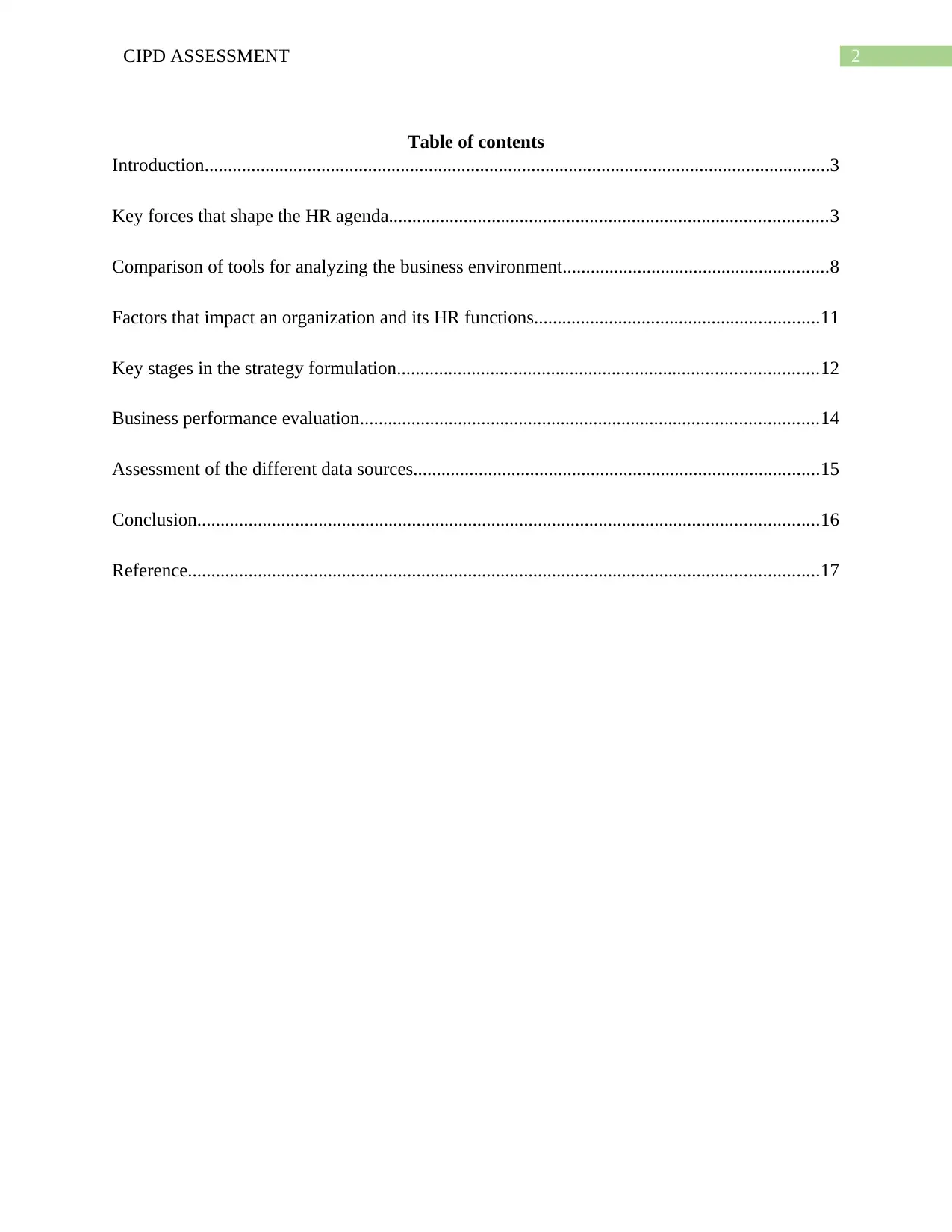
2CIPD ASSESSMENT
Table of contents
Introduction......................................................................................................................................3
Key forces that shape the HR agenda..............................................................................................3
Comparison of tools for analyzing the business environment.........................................................8
Factors that impact an organization and its HR functions.............................................................11
Key stages in the strategy formulation..........................................................................................12
Business performance evaluation..................................................................................................14
Assessment of the different data sources.......................................................................................15
Conclusion.....................................................................................................................................16
Reference.......................................................................................................................................17
Table of contents
Introduction......................................................................................................................................3
Key forces that shape the HR agenda..............................................................................................3
Comparison of tools for analyzing the business environment.........................................................8
Factors that impact an organization and its HR functions.............................................................11
Key stages in the strategy formulation..........................................................................................12
Business performance evaluation..................................................................................................14
Assessment of the different data sources.......................................................................................15
Conclusion.....................................................................................................................................16
Reference.......................................................................................................................................17
⊘ This is a preview!⊘
Do you want full access?
Subscribe today to unlock all pages.

Trusted by 1+ million students worldwide
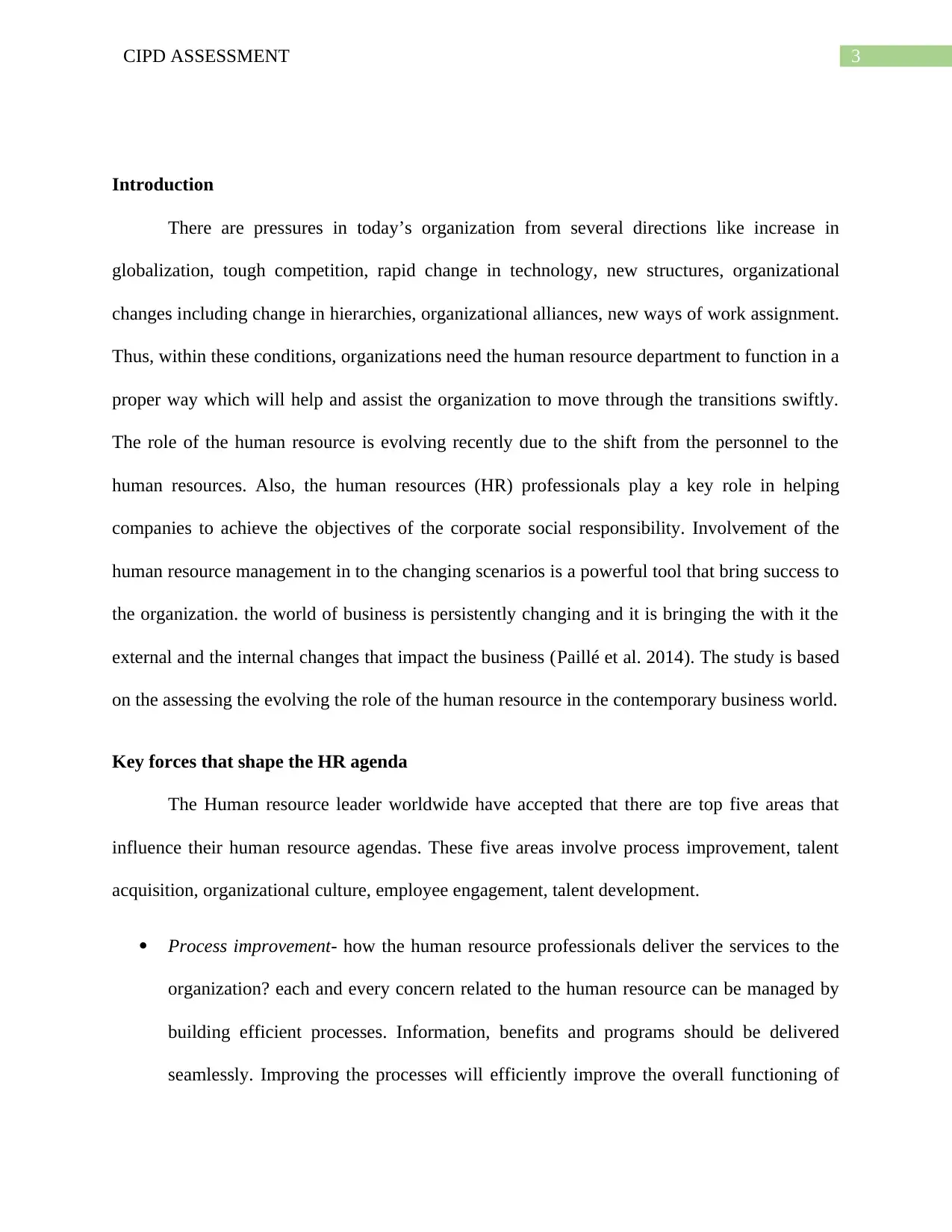
3CIPD ASSESSMENT
Introduction
There are pressures in today’s organization from several directions like increase in
globalization, tough competition, rapid change in technology, new structures, organizational
changes including change in hierarchies, organizational alliances, new ways of work assignment.
Thus, within these conditions, organizations need the human resource department to function in a
proper way which will help and assist the organization to move through the transitions swiftly.
The role of the human resource is evolving recently due to the shift from the personnel to the
human resources. Also, the human resources (HR) professionals play a key role in helping
companies to achieve the objectives of the corporate social responsibility. Involvement of the
human resource management in to the changing scenarios is a powerful tool that bring success to
the organization. the world of business is persistently changing and it is bringing the with it the
external and the internal changes that impact the business (Paillé et al. 2014). The study is based
on the assessing the evolving the role of the human resource in the contemporary business world.
Key forces that shape the HR agenda
The Human resource leader worldwide have accepted that there are top five areas that
influence their human resource agendas. These five areas involve process improvement, talent
acquisition, organizational culture, employee engagement, talent development.
Process improvement- how the human resource professionals deliver the services to the
organization? each and every concern related to the human resource can be managed by
building efficient processes. Information, benefits and programs should be delivered
seamlessly. Improving the processes will efficiently improve the overall functioning of
Introduction
There are pressures in today’s organization from several directions like increase in
globalization, tough competition, rapid change in technology, new structures, organizational
changes including change in hierarchies, organizational alliances, new ways of work assignment.
Thus, within these conditions, organizations need the human resource department to function in a
proper way which will help and assist the organization to move through the transitions swiftly.
The role of the human resource is evolving recently due to the shift from the personnel to the
human resources. Also, the human resources (HR) professionals play a key role in helping
companies to achieve the objectives of the corporate social responsibility. Involvement of the
human resource management in to the changing scenarios is a powerful tool that bring success to
the organization. the world of business is persistently changing and it is bringing the with it the
external and the internal changes that impact the business (Paillé et al. 2014). The study is based
on the assessing the evolving the role of the human resource in the contemporary business world.
Key forces that shape the HR agenda
The Human resource leader worldwide have accepted that there are top five areas that
influence their human resource agendas. These five areas involve process improvement, talent
acquisition, organizational culture, employee engagement, talent development.
Process improvement- how the human resource professionals deliver the services to the
organization? each and every concern related to the human resource can be managed by
building efficient processes. Information, benefits and programs should be delivered
seamlessly. Improving the processes will efficiently improve the overall functioning of
Paraphrase This Document
Need a fresh take? Get an instant paraphrase of this document with our AI Paraphraser
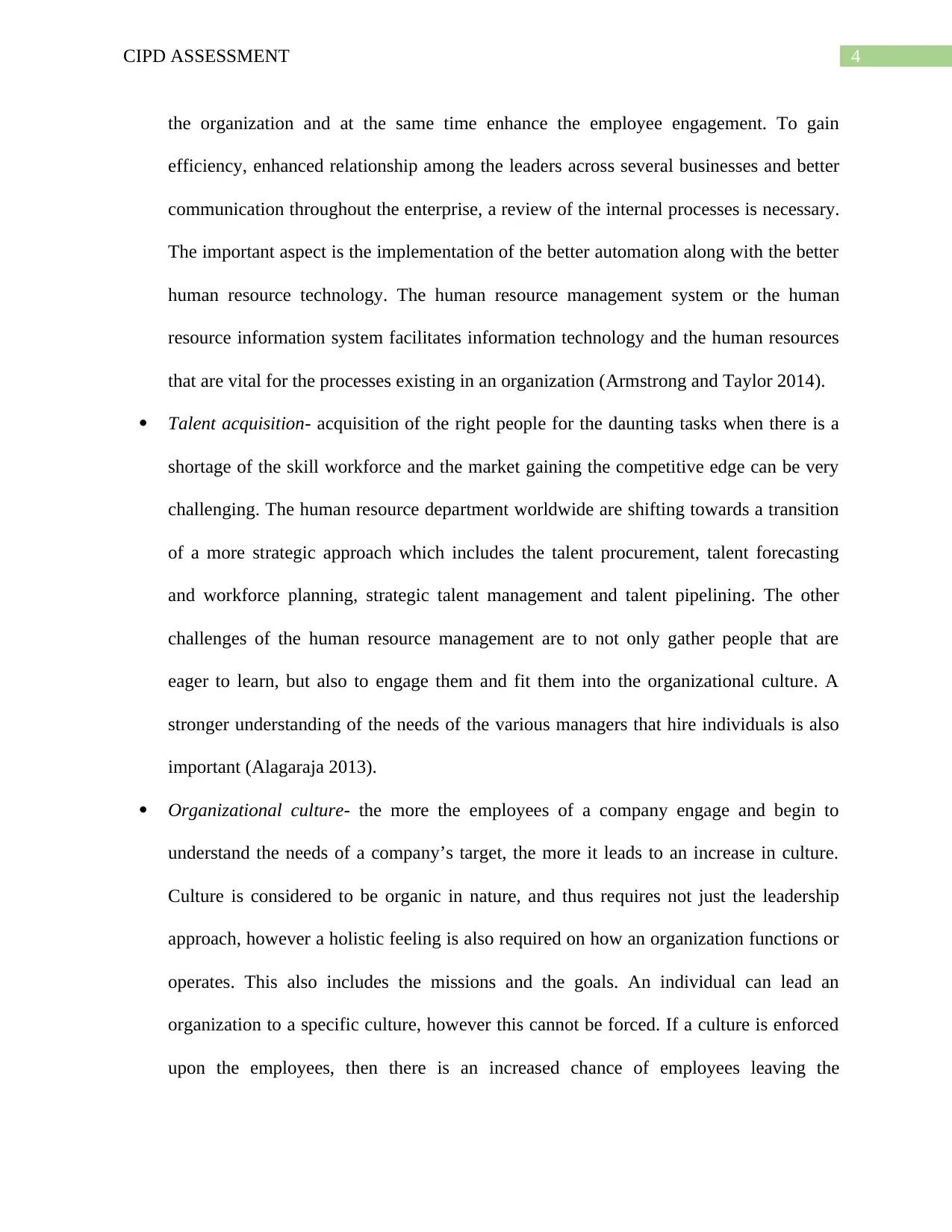
4CIPD ASSESSMENT
the organization and at the same time enhance the employee engagement. To gain
efficiency, enhanced relationship among the leaders across several businesses and better
communication throughout the enterprise, a review of the internal processes is necessary.
The important aspect is the implementation of the better automation along with the better
human resource technology. The human resource management system or the human
resource information system facilitates information technology and the human resources
that are vital for the processes existing in an organization (Armstrong and Taylor 2014).
Talent acquisition- acquisition of the right people for the daunting tasks when there is a
shortage of the skill workforce and the market gaining the competitive edge can be very
challenging. The human resource department worldwide are shifting towards a transition
of a more strategic approach which includes the talent procurement, talent forecasting
and workforce planning, strategic talent management and talent pipelining. The other
challenges of the human resource management are to not only gather people that are
eager to learn, but also to engage them and fit them into the organizational culture. A
stronger understanding of the needs of the various managers that hire individuals is also
important (Alagaraja 2013).
Organizational culture- the more the employees of a company engage and begin to
understand the needs of a company’s target, the more it leads to an increase in culture.
Culture is considered to be organic in nature, and thus requires not just the leadership
approach, however a holistic feeling is also required on how an organization functions or
operates. This also includes the missions and the goals. An individual can lead an
organization to a specific culture, however this cannot be forced. If a culture is enforced
upon the employees, then there is an increased chance of employees leaving the
the organization and at the same time enhance the employee engagement. To gain
efficiency, enhanced relationship among the leaders across several businesses and better
communication throughout the enterprise, a review of the internal processes is necessary.
The important aspect is the implementation of the better automation along with the better
human resource technology. The human resource management system or the human
resource information system facilitates information technology and the human resources
that are vital for the processes existing in an organization (Armstrong and Taylor 2014).
Talent acquisition- acquisition of the right people for the daunting tasks when there is a
shortage of the skill workforce and the market gaining the competitive edge can be very
challenging. The human resource department worldwide are shifting towards a transition
of a more strategic approach which includes the talent procurement, talent forecasting
and workforce planning, strategic talent management and talent pipelining. The other
challenges of the human resource management are to not only gather people that are
eager to learn, but also to engage them and fit them into the organizational culture. A
stronger understanding of the needs of the various managers that hire individuals is also
important (Alagaraja 2013).
Organizational culture- the more the employees of a company engage and begin to
understand the needs of a company’s target, the more it leads to an increase in culture.
Culture is considered to be organic in nature, and thus requires not just the leadership
approach, however a holistic feeling is also required on how an organization functions or
operates. This also includes the missions and the goals. An individual can lead an
organization to a specific culture, however this cannot be forced. If a culture is enforced
upon the employees, then there is an increased chance of employees leaving the
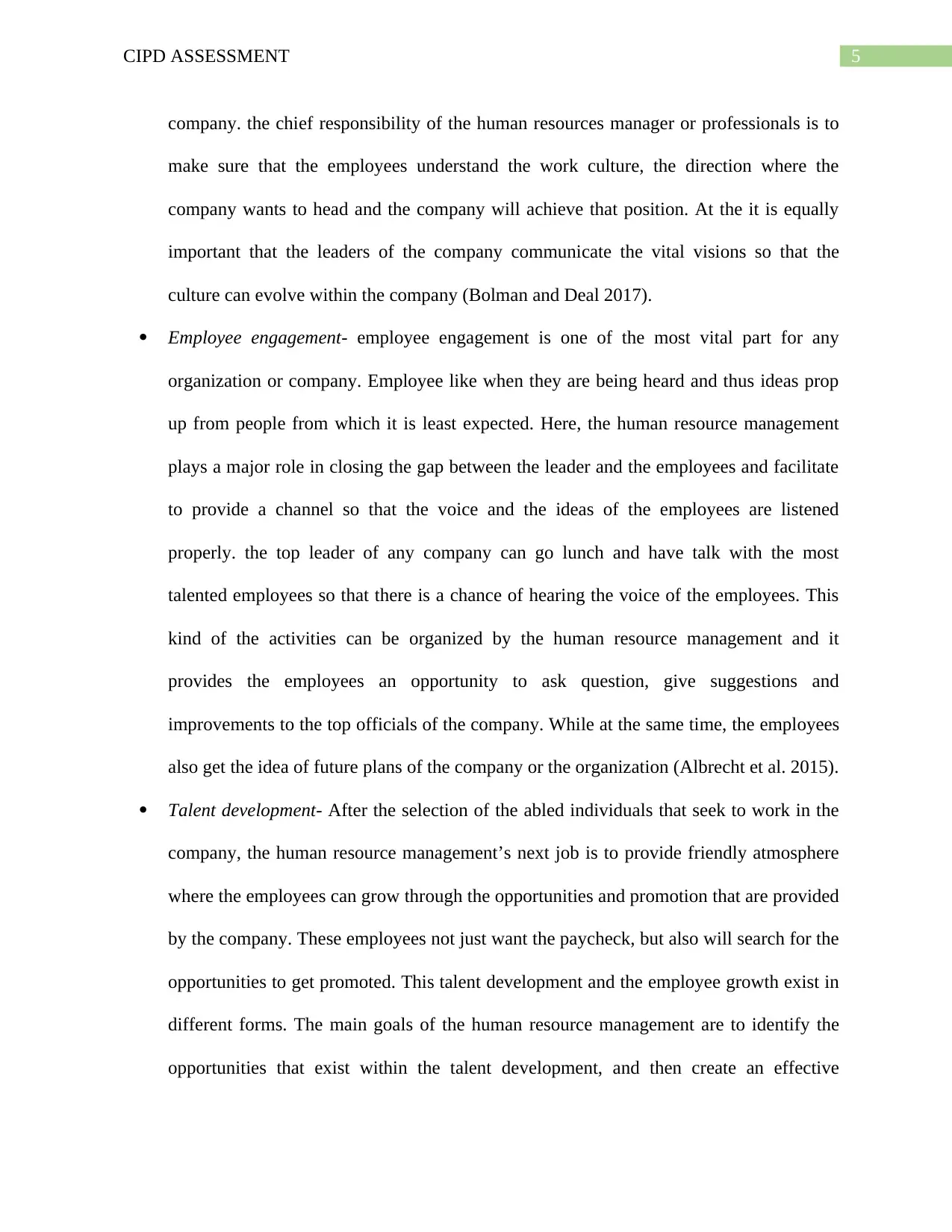
5CIPD ASSESSMENT
company. the chief responsibility of the human resources manager or professionals is to
make sure that the employees understand the work culture, the direction where the
company wants to head and the company will achieve that position. At the it is equally
important that the leaders of the company communicate the vital visions so that the
culture can evolve within the company (Bolman and Deal 2017).
Employee engagement- employee engagement is one of the most vital part for any
organization or company. Employee like when they are being heard and thus ideas prop
up from people from which it is least expected. Here, the human resource management
plays a major role in closing the gap between the leader and the employees and facilitate
to provide a channel so that the voice and the ideas of the employees are listened
properly. the top leader of any company can go lunch and have talk with the most
talented employees so that there is a chance of hearing the voice of the employees. This
kind of the activities can be organized by the human resource management and it
provides the employees an opportunity to ask question, give suggestions and
improvements to the top officials of the company. While at the same time, the employees
also get the idea of future plans of the company or the organization (Albrecht et al. 2015).
Talent development- After the selection of the abled individuals that seek to work in the
company, the human resource management’s next job is to provide friendly atmosphere
where the employees can grow through the opportunities and promotion that are provided
by the company. These employees not just want the paycheck, but also will search for the
opportunities to get promoted. This talent development and the employee growth exist in
different forms. The main goals of the human resource management are to identify the
opportunities that exist within the talent development, and then create an effective
company. the chief responsibility of the human resources manager or professionals is to
make sure that the employees understand the work culture, the direction where the
company wants to head and the company will achieve that position. At the it is equally
important that the leaders of the company communicate the vital visions so that the
culture can evolve within the company (Bolman and Deal 2017).
Employee engagement- employee engagement is one of the most vital part for any
organization or company. Employee like when they are being heard and thus ideas prop
up from people from which it is least expected. Here, the human resource management
plays a major role in closing the gap between the leader and the employees and facilitate
to provide a channel so that the voice and the ideas of the employees are listened
properly. the top leader of any company can go lunch and have talk with the most
talented employees so that there is a chance of hearing the voice of the employees. This
kind of the activities can be organized by the human resource management and it
provides the employees an opportunity to ask question, give suggestions and
improvements to the top officials of the company. While at the same time, the employees
also get the idea of future plans of the company or the organization (Albrecht et al. 2015).
Talent development- After the selection of the abled individuals that seek to work in the
company, the human resource management’s next job is to provide friendly atmosphere
where the employees can grow through the opportunities and promotion that are provided
by the company. These employees not just want the paycheck, but also will search for the
opportunities to get promoted. This talent development and the employee growth exist in
different forms. The main goals of the human resource management are to identify the
opportunities that exist within the talent development, and then create an effective
⊘ This is a preview!⊘
Do you want full access?
Subscribe today to unlock all pages.

Trusted by 1+ million students worldwide
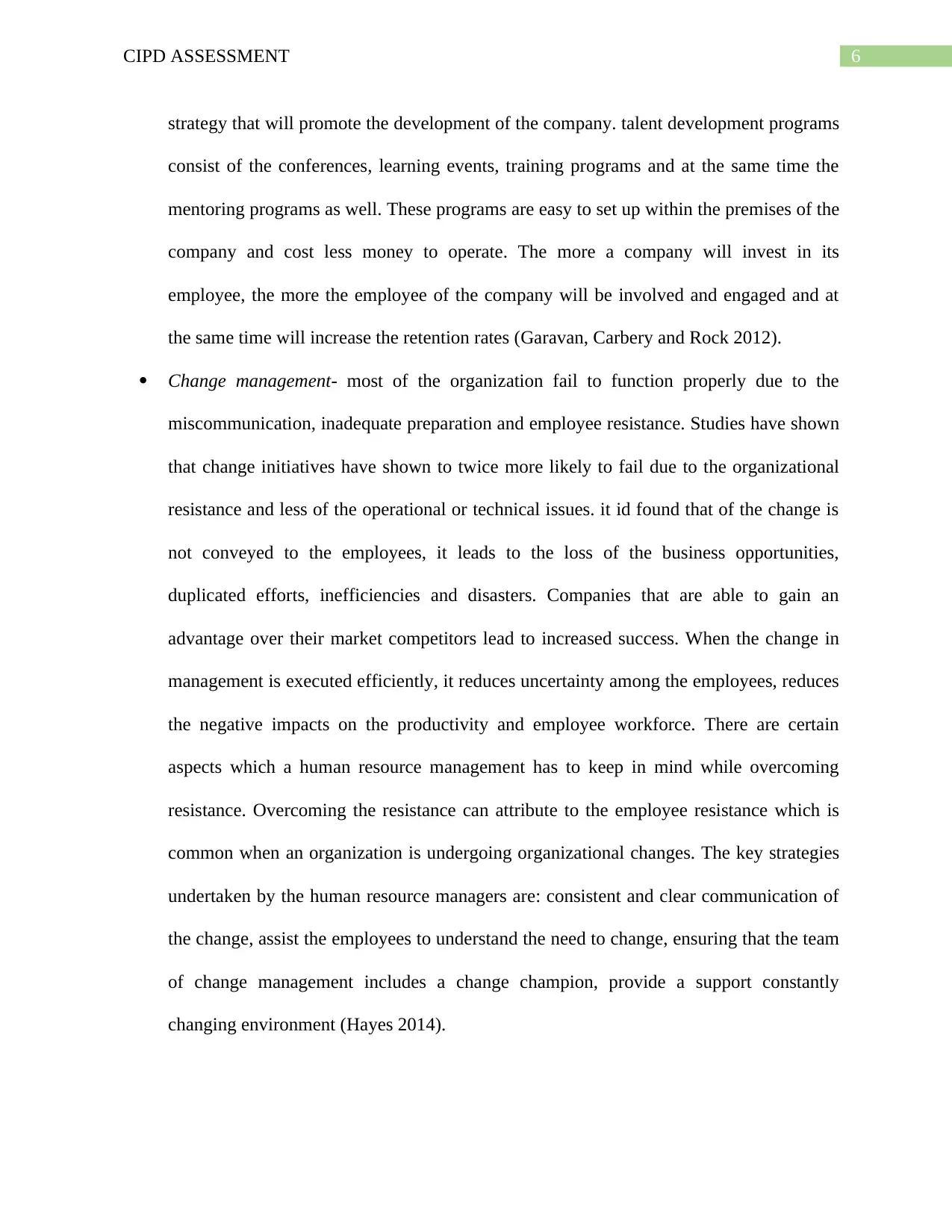
6CIPD ASSESSMENT
strategy that will promote the development of the company. talent development programs
consist of the conferences, learning events, training programs and at the same time the
mentoring programs as well. These programs are easy to set up within the premises of the
company and cost less money to operate. The more a company will invest in its
employee, the more the employee of the company will be involved and engaged and at
the same time will increase the retention rates (Garavan, Carbery and Rock 2012).
Change management- most of the organization fail to function properly due to the
miscommunication, inadequate preparation and employee resistance. Studies have shown
that change initiatives have shown to twice more likely to fail due to the organizational
resistance and less of the operational or technical issues. it id found that of the change is
not conveyed to the employees, it leads to the loss of the business opportunities,
duplicated efforts, inefficiencies and disasters. Companies that are able to gain an
advantage over their market competitors lead to increased success. When the change in
management is executed efficiently, it reduces uncertainty among the employees, reduces
the negative impacts on the productivity and employee workforce. There are certain
aspects which a human resource management has to keep in mind while overcoming
resistance. Overcoming the resistance can attribute to the employee resistance which is
common when an organization is undergoing organizational changes. The key strategies
undertaken by the human resource managers are: consistent and clear communication of
the change, assist the employees to understand the need to change, ensuring that the team
of change management includes a change champion, provide a support constantly
changing environment (Hayes 2014).
strategy that will promote the development of the company. talent development programs
consist of the conferences, learning events, training programs and at the same time the
mentoring programs as well. These programs are easy to set up within the premises of the
company and cost less money to operate. The more a company will invest in its
employee, the more the employee of the company will be involved and engaged and at
the same time will increase the retention rates (Garavan, Carbery and Rock 2012).
Change management- most of the organization fail to function properly due to the
miscommunication, inadequate preparation and employee resistance. Studies have shown
that change initiatives have shown to twice more likely to fail due to the organizational
resistance and less of the operational or technical issues. it id found that of the change is
not conveyed to the employees, it leads to the loss of the business opportunities,
duplicated efforts, inefficiencies and disasters. Companies that are able to gain an
advantage over their market competitors lead to increased success. When the change in
management is executed efficiently, it reduces uncertainty among the employees, reduces
the negative impacts on the productivity and employee workforce. There are certain
aspects which a human resource management has to keep in mind while overcoming
resistance. Overcoming the resistance can attribute to the employee resistance which is
common when an organization is undergoing organizational changes. The key strategies
undertaken by the human resource managers are: consistent and clear communication of
the change, assist the employees to understand the need to change, ensuring that the team
of change management includes a change champion, provide a support constantly
changing environment (Hayes 2014).
Paraphrase This Document
Need a fresh take? Get an instant paraphrase of this document with our AI Paraphraser
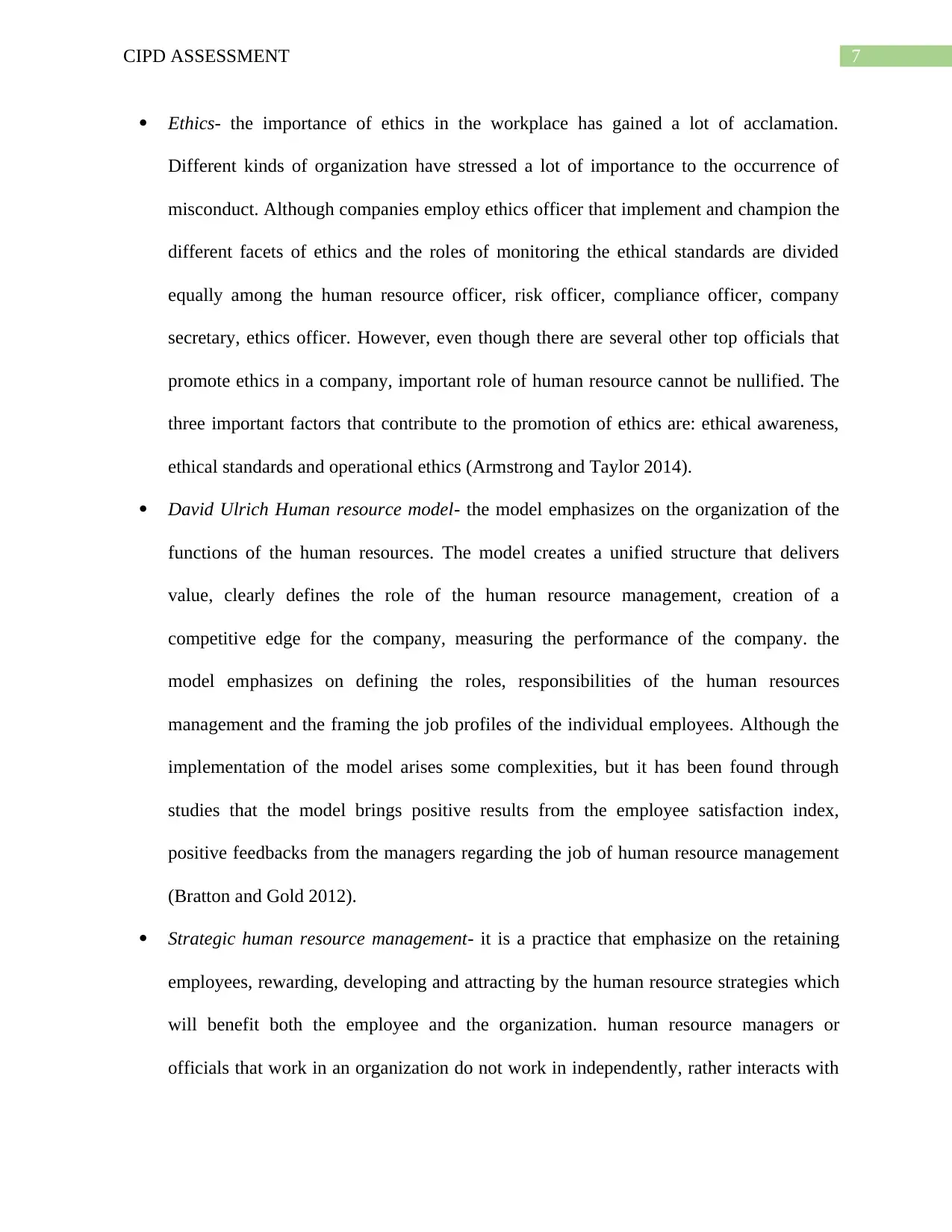
7CIPD ASSESSMENT
Ethics- the importance of ethics in the workplace has gained a lot of acclamation.
Different kinds of organization have stressed a lot of importance to the occurrence of
misconduct. Although companies employ ethics officer that implement and champion the
different facets of ethics and the roles of monitoring the ethical standards are divided
equally among the human resource officer, risk officer, compliance officer, company
secretary, ethics officer. However, even though there are several other top officials that
promote ethics in a company, important role of human resource cannot be nullified. The
three important factors that contribute to the promotion of ethics are: ethical awareness,
ethical standards and operational ethics (Armstrong and Taylor 2014).
David Ulrich Human resource model- the model emphasizes on the organization of the
functions of the human resources. The model creates a unified structure that delivers
value, clearly defines the role of the human resource management, creation of a
competitive edge for the company, measuring the performance of the company. the
model emphasizes on defining the roles, responsibilities of the human resources
management and the framing the job profiles of the individual employees. Although the
implementation of the model arises some complexities, but it has been found through
studies that the model brings positive results from the employee satisfaction index,
positive feedbacks from the managers regarding the job of human resource management
(Bratton and Gold 2012).
Strategic human resource management- it is a practice that emphasize on the retaining
employees, rewarding, developing and attracting by the human resource strategies which
will benefit both the employee and the organization. human resource managers or
officials that work in an organization do not work in independently, rather interacts with
Ethics- the importance of ethics in the workplace has gained a lot of acclamation.
Different kinds of organization have stressed a lot of importance to the occurrence of
misconduct. Although companies employ ethics officer that implement and champion the
different facets of ethics and the roles of monitoring the ethical standards are divided
equally among the human resource officer, risk officer, compliance officer, company
secretary, ethics officer. However, even though there are several other top officials that
promote ethics in a company, important role of human resource cannot be nullified. The
three important factors that contribute to the promotion of ethics are: ethical awareness,
ethical standards and operational ethics (Armstrong and Taylor 2014).
David Ulrich Human resource model- the model emphasizes on the organization of the
functions of the human resources. The model creates a unified structure that delivers
value, clearly defines the role of the human resource management, creation of a
competitive edge for the company, measuring the performance of the company. the
model emphasizes on defining the roles, responsibilities of the human resources
management and the framing the job profiles of the individual employees. Although the
implementation of the model arises some complexities, but it has been found through
studies that the model brings positive results from the employee satisfaction index,
positive feedbacks from the managers regarding the job of human resource management
(Bratton and Gold 2012).
Strategic human resource management- it is a practice that emphasize on the retaining
employees, rewarding, developing and attracting by the human resource strategies which
will benefit both the employee and the organization. human resource managers or
officials that work in an organization do not work in independently, rather interacts with
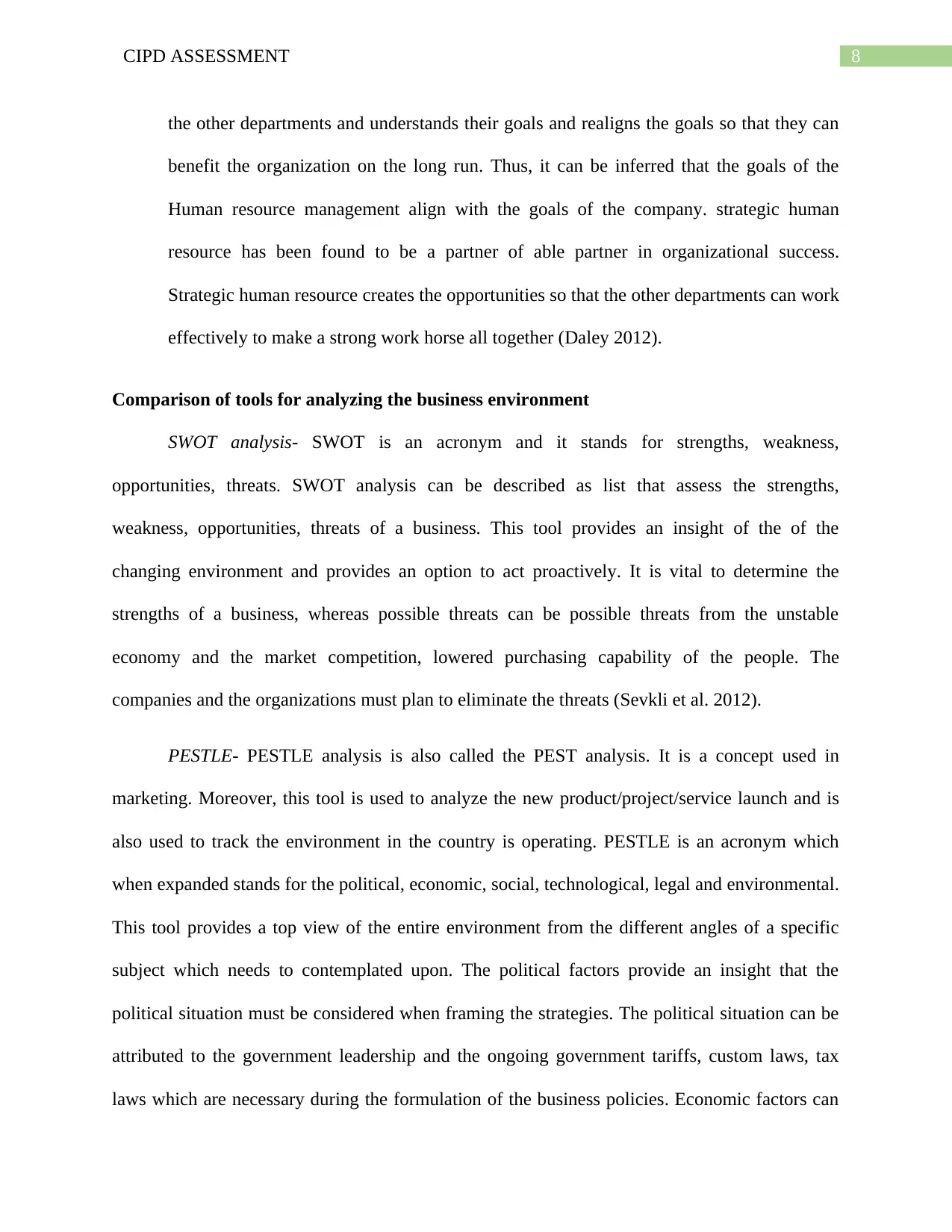
8CIPD ASSESSMENT
the other departments and understands their goals and realigns the goals so that they can
benefit the organization on the long run. Thus, it can be inferred that the goals of the
Human resource management align with the goals of the company. strategic human
resource has been found to be a partner of able partner in organizational success.
Strategic human resource creates the opportunities so that the other departments can work
effectively to make a strong work horse all together (Daley 2012).
Comparison of tools for analyzing the business environment
SWOT analysis- SWOT is an acronym and it stands for strengths, weakness,
opportunities, threats. SWOT analysis can be described as list that assess the strengths,
weakness, opportunities, threats of a business. This tool provides an insight of the of the
changing environment and provides an option to act proactively. It is vital to determine the
strengths of a business, whereas possible threats can be possible threats from the unstable
economy and the market competition, lowered purchasing capability of the people. The
companies and the organizations must plan to eliminate the threats (Sevkli et al. 2012).
PESTLE- PESTLE analysis is also called the PEST analysis. It is a concept used in
marketing. Moreover, this tool is used to analyze the new product/project/service launch and is
also used to track the environment in the country is operating. PESTLE is an acronym which
when expanded stands for the political, economic, social, technological, legal and environmental.
This tool provides a top view of the entire environment from the different angles of a specific
subject which needs to contemplated upon. The political factors provide an insight that the
political situation must be considered when framing the strategies. The political situation can be
attributed to the government leadership and the ongoing government tariffs, custom laws, tax
laws which are necessary during the formulation of the business policies. Economic factors can
the other departments and understands their goals and realigns the goals so that they can
benefit the organization on the long run. Thus, it can be inferred that the goals of the
Human resource management align with the goals of the company. strategic human
resource has been found to be a partner of able partner in organizational success.
Strategic human resource creates the opportunities so that the other departments can work
effectively to make a strong work horse all together (Daley 2012).
Comparison of tools for analyzing the business environment
SWOT analysis- SWOT is an acronym and it stands for strengths, weakness,
opportunities, threats. SWOT analysis can be described as list that assess the strengths,
weakness, opportunities, threats of a business. This tool provides an insight of the of the
changing environment and provides an option to act proactively. It is vital to determine the
strengths of a business, whereas possible threats can be possible threats from the unstable
economy and the market competition, lowered purchasing capability of the people. The
companies and the organizations must plan to eliminate the threats (Sevkli et al. 2012).
PESTLE- PESTLE analysis is also called the PEST analysis. It is a concept used in
marketing. Moreover, this tool is used to analyze the new product/project/service launch and is
also used to track the environment in the country is operating. PESTLE is an acronym which
when expanded stands for the political, economic, social, technological, legal and environmental.
This tool provides a top view of the entire environment from the different angles of a specific
subject which needs to contemplated upon. The political factors provide an insight that the
political situation must be considered when framing the strategies. The political situation can be
attributed to the government leadership and the ongoing government tariffs, custom laws, tax
laws which are necessary during the formulation of the business policies. Economic factors can
⊘ This is a preview!⊘
Do you want full access?
Subscribe today to unlock all pages.

Trusted by 1+ million students worldwide
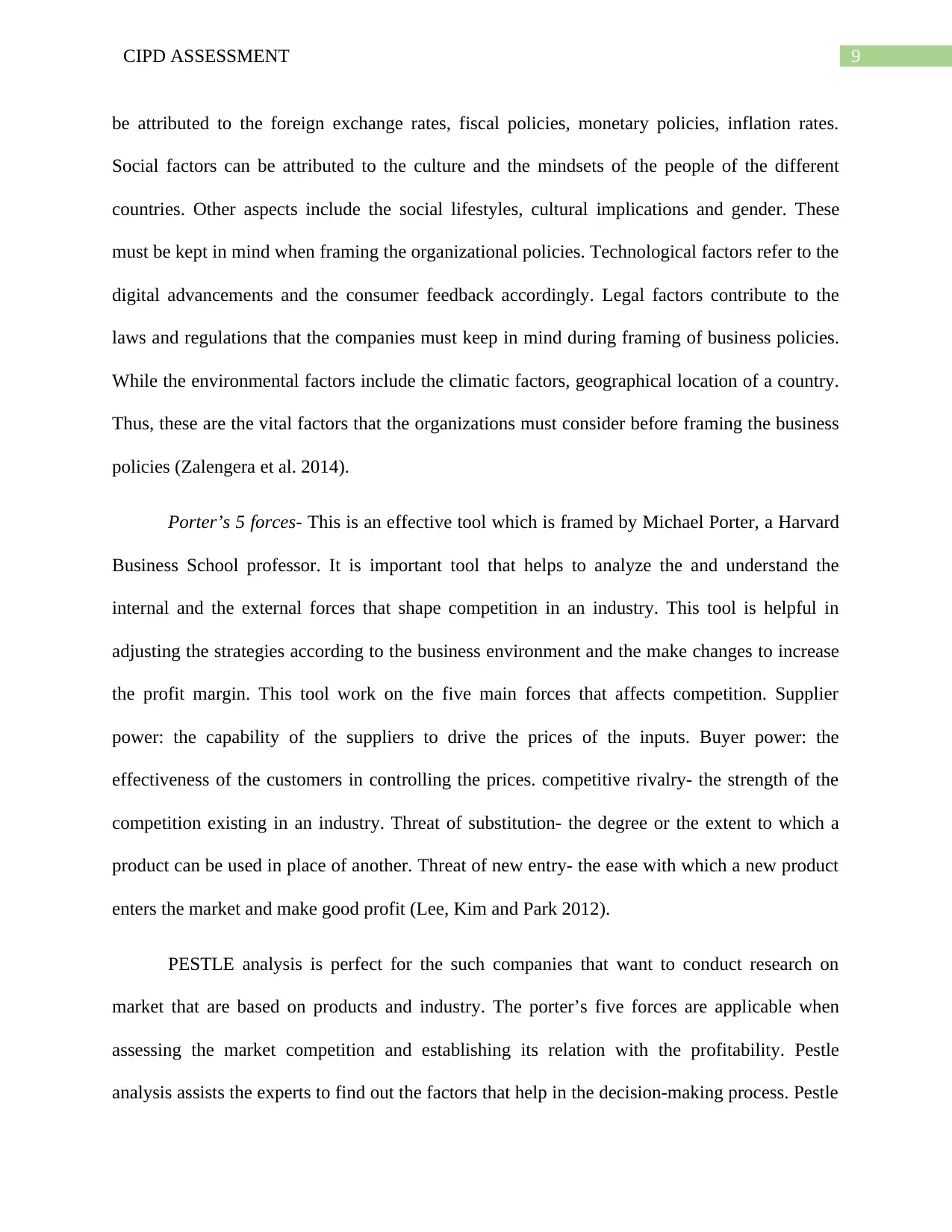
9CIPD ASSESSMENT
be attributed to the foreign exchange rates, fiscal policies, monetary policies, inflation rates.
Social factors can be attributed to the culture and the mindsets of the people of the different
countries. Other aspects include the social lifestyles, cultural implications and gender. These
must be kept in mind when framing the organizational policies. Technological factors refer to the
digital advancements and the consumer feedback accordingly. Legal factors contribute to the
laws and regulations that the companies must keep in mind during framing of business policies.
While the environmental factors include the climatic factors, geographical location of a country.
Thus, these are the vital factors that the organizations must consider before framing the business
policies (Zalengera et al. 2014).
Porter’s 5 forces- This is an effective tool which is framed by Michael Porter, a Harvard
Business School professor. It is important tool that helps to analyze the and understand the
internal and the external forces that shape competition in an industry. This tool is helpful in
adjusting the strategies according to the business environment and the make changes to increase
the profit margin. This tool work on the five main forces that affects competition. Supplier
power: the capability of the suppliers to drive the prices of the inputs. Buyer power: the
effectiveness of the customers in controlling the prices. competitive rivalry- the strength of the
competition existing in an industry. Threat of substitution- the degree or the extent to which a
product can be used in place of another. Threat of new entry- the ease with which a new product
enters the market and make good profit (Lee, Kim and Park 2012).
PESTLE analysis is perfect for the such companies that want to conduct research on
market that are based on products and industry. The porter’s five forces are applicable when
assessing the market competition and establishing its relation with the profitability. Pestle
analysis assists the experts to find out the factors that help in the decision-making process. Pestle
be attributed to the foreign exchange rates, fiscal policies, monetary policies, inflation rates.
Social factors can be attributed to the culture and the mindsets of the people of the different
countries. Other aspects include the social lifestyles, cultural implications and gender. These
must be kept in mind when framing the organizational policies. Technological factors refer to the
digital advancements and the consumer feedback accordingly. Legal factors contribute to the
laws and regulations that the companies must keep in mind during framing of business policies.
While the environmental factors include the climatic factors, geographical location of a country.
Thus, these are the vital factors that the organizations must consider before framing the business
policies (Zalengera et al. 2014).
Porter’s 5 forces- This is an effective tool which is framed by Michael Porter, a Harvard
Business School professor. It is important tool that helps to analyze the and understand the
internal and the external forces that shape competition in an industry. This tool is helpful in
adjusting the strategies according to the business environment and the make changes to increase
the profit margin. This tool work on the five main forces that affects competition. Supplier
power: the capability of the suppliers to drive the prices of the inputs. Buyer power: the
effectiveness of the customers in controlling the prices. competitive rivalry- the strength of the
competition existing in an industry. Threat of substitution- the degree or the extent to which a
product can be used in place of another. Threat of new entry- the ease with which a new product
enters the market and make good profit (Lee, Kim and Park 2012).
PESTLE analysis is perfect for the such companies that want to conduct research on
market that are based on products and industry. The porter’s five forces are applicable when
assessing the market competition and establishing its relation with the profitability. Pestle
analysis assists the experts to find out the factors that help in the decision-making process. Pestle
Paraphrase This Document
Need a fresh take? Get an instant paraphrase of this document with our AI Paraphraser
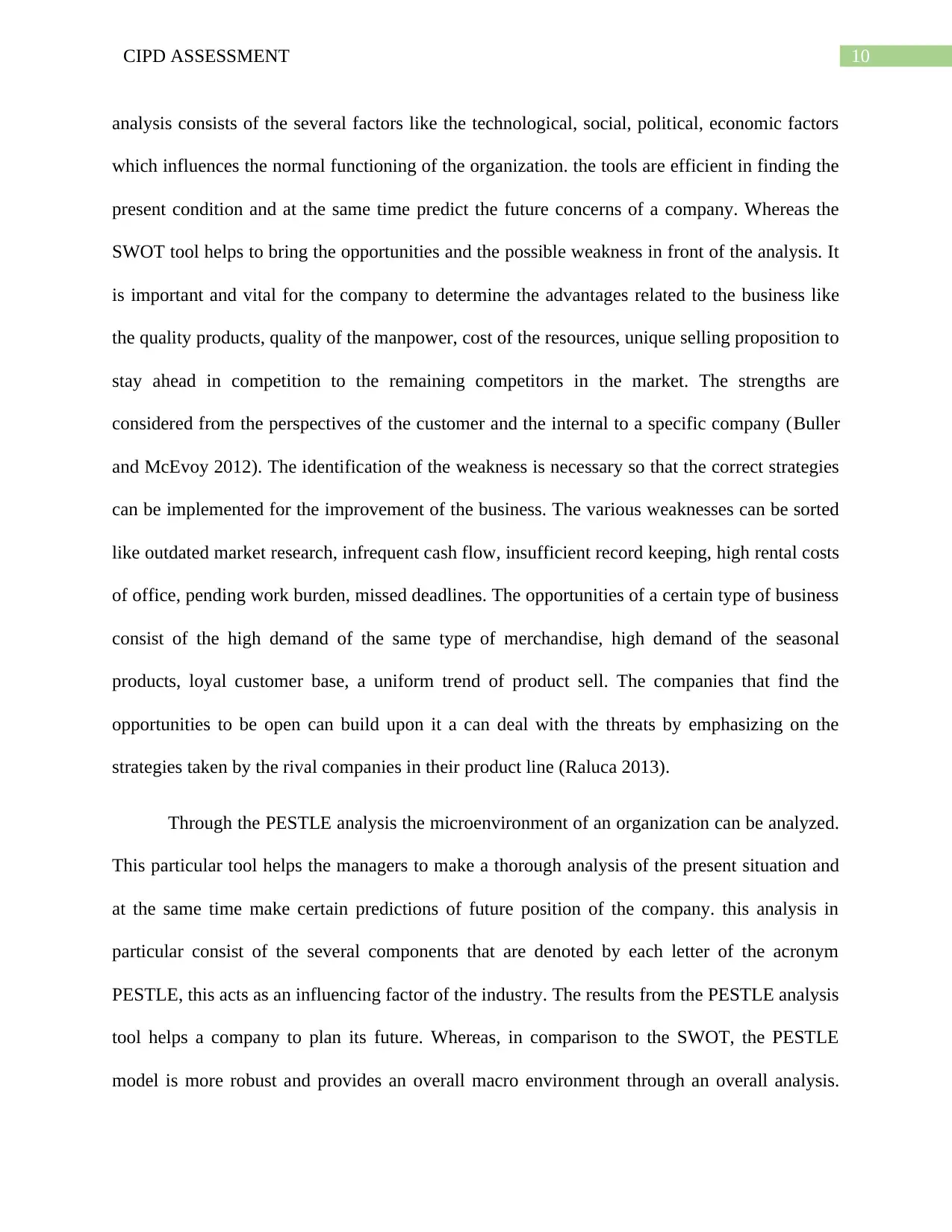
10CIPD ASSESSMENT
analysis consists of the several factors like the technological, social, political, economic factors
which influences the normal functioning of the organization. the tools are efficient in finding the
present condition and at the same time predict the future concerns of a company. Whereas the
SWOT tool helps to bring the opportunities and the possible weakness in front of the analysis. It
is important and vital for the company to determine the advantages related to the business like
the quality products, quality of the manpower, cost of the resources, unique selling proposition to
stay ahead in competition to the remaining competitors in the market. The strengths are
considered from the perspectives of the customer and the internal to a specific company (Buller
and McEvoy 2012). The identification of the weakness is necessary so that the correct strategies
can be implemented for the improvement of the business. The various weaknesses can be sorted
like outdated market research, infrequent cash flow, insufficient record keeping, high rental costs
of office, pending work burden, missed deadlines. The opportunities of a certain type of business
consist of the high demand of the same type of merchandise, high demand of the seasonal
products, loyal customer base, a uniform trend of product sell. The companies that find the
opportunities to be open can build upon it a can deal with the threats by emphasizing on the
strategies taken by the rival companies in their product line (Raluca 2013).
Through the PESTLE analysis the microenvironment of an organization can be analyzed.
This particular tool helps the managers to make a thorough analysis of the present situation and
at the same time make certain predictions of future position of the company. this analysis in
particular consist of the several components that are denoted by each letter of the acronym
PESTLE, this acts as an influencing factor of the industry. The results from the PESTLE analysis
tool helps a company to plan its future. Whereas, in comparison to the SWOT, the PESTLE
model is more robust and provides an overall macro environment through an overall analysis.
analysis consists of the several factors like the technological, social, political, economic factors
which influences the normal functioning of the organization. the tools are efficient in finding the
present condition and at the same time predict the future concerns of a company. Whereas the
SWOT tool helps to bring the opportunities and the possible weakness in front of the analysis. It
is important and vital for the company to determine the advantages related to the business like
the quality products, quality of the manpower, cost of the resources, unique selling proposition to
stay ahead in competition to the remaining competitors in the market. The strengths are
considered from the perspectives of the customer and the internal to a specific company (Buller
and McEvoy 2012). The identification of the weakness is necessary so that the correct strategies
can be implemented for the improvement of the business. The various weaknesses can be sorted
like outdated market research, infrequent cash flow, insufficient record keeping, high rental costs
of office, pending work burden, missed deadlines. The opportunities of a certain type of business
consist of the high demand of the same type of merchandise, high demand of the seasonal
products, loyal customer base, a uniform trend of product sell. The companies that find the
opportunities to be open can build upon it a can deal with the threats by emphasizing on the
strategies taken by the rival companies in their product line (Raluca 2013).
Through the PESTLE analysis the microenvironment of an organization can be analyzed.
This particular tool helps the managers to make a thorough analysis of the present situation and
at the same time make certain predictions of future position of the company. this analysis in
particular consist of the several components that are denoted by each letter of the acronym
PESTLE, this acts as an influencing factor of the industry. The results from the PESTLE analysis
tool helps a company to plan its future. Whereas, in comparison to the SWOT, the PESTLE
model is more robust and provides an overall macro environment through an overall analysis.
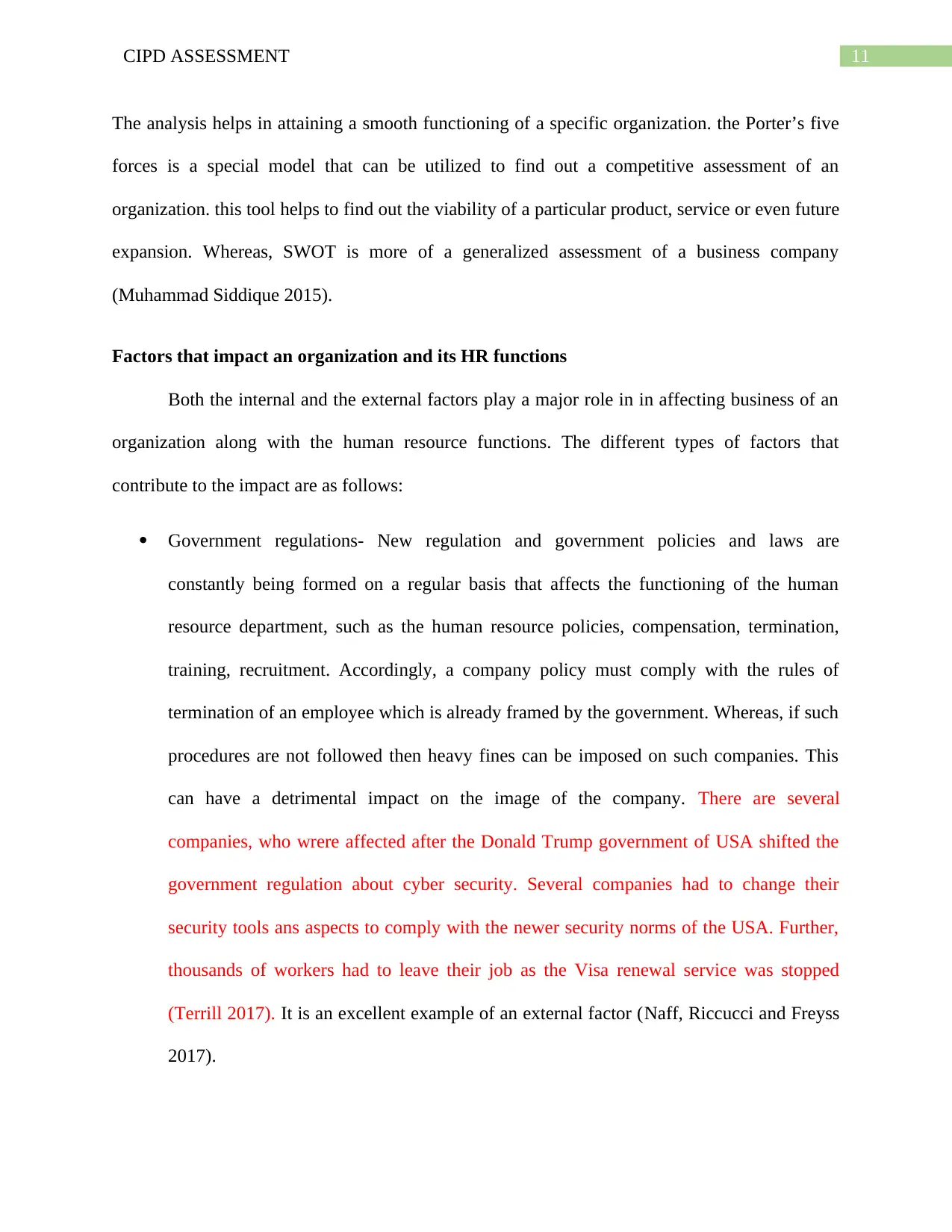
11CIPD ASSESSMENT
The analysis helps in attaining a smooth functioning of a specific organization. the Porter’s five
forces is a special model that can be utilized to find out a competitive assessment of an
organization. this tool helps to find out the viability of a particular product, service or even future
expansion. Whereas, SWOT is more of a generalized assessment of a business company
(Muhammad Siddique 2015).
Factors that impact an organization and its HR functions
Both the internal and the external factors play a major role in in affecting business of an
organization along with the human resource functions. The different types of factors that
contribute to the impact are as follows:
Government regulations- New regulation and government policies and laws are
constantly being formed on a regular basis that affects the functioning of the human
resource department, such as the human resource policies, compensation, termination,
training, recruitment. Accordingly, a company policy must comply with the rules of
termination of an employee which is already framed by the government. Whereas, if such
procedures are not followed then heavy fines can be imposed on such companies. This
can have a detrimental impact on the image of the company. There are several
companies, who wrere affected after the Donald Trump government of USA shifted the
government regulation about cyber security. Several companies had to change their
security tools ans aspects to comply with the newer security norms of the USA. Further,
thousands of workers had to leave their job as the Visa renewal service was stopped
(Terrill 2017). It is an excellent example of an external factor (Naff, Riccucci and Freyss
2017).
The analysis helps in attaining a smooth functioning of a specific organization. the Porter’s five
forces is a special model that can be utilized to find out a competitive assessment of an
organization. this tool helps to find out the viability of a particular product, service or even future
expansion. Whereas, SWOT is more of a generalized assessment of a business company
(Muhammad Siddique 2015).
Factors that impact an organization and its HR functions
Both the internal and the external factors play a major role in in affecting business of an
organization along with the human resource functions. The different types of factors that
contribute to the impact are as follows:
Government regulations- New regulation and government policies and laws are
constantly being formed on a regular basis that affects the functioning of the human
resource department, such as the human resource policies, compensation, termination,
training, recruitment. Accordingly, a company policy must comply with the rules of
termination of an employee which is already framed by the government. Whereas, if such
procedures are not followed then heavy fines can be imposed on such companies. This
can have a detrimental impact on the image of the company. There are several
companies, who wrere affected after the Donald Trump government of USA shifted the
government regulation about cyber security. Several companies had to change their
security tools ans aspects to comply with the newer security norms of the USA. Further,
thousands of workers had to leave their job as the Visa renewal service was stopped
(Terrill 2017). It is an excellent example of an external factor (Naff, Riccucci and Freyss
2017).
⊘ This is a preview!⊘
Do you want full access?
Subscribe today to unlock all pages.

Trusted by 1+ million students worldwide
1 out of 22
Related Documents
Your All-in-One AI-Powered Toolkit for Academic Success.
+13062052269
info@desklib.com
Available 24*7 on WhatsApp / Email
![[object Object]](/_next/static/media/star-bottom.7253800d.svg)
Unlock your academic potential
Copyright © 2020–2025 A2Z Services. All Rights Reserved. Developed and managed by ZUCOL.





